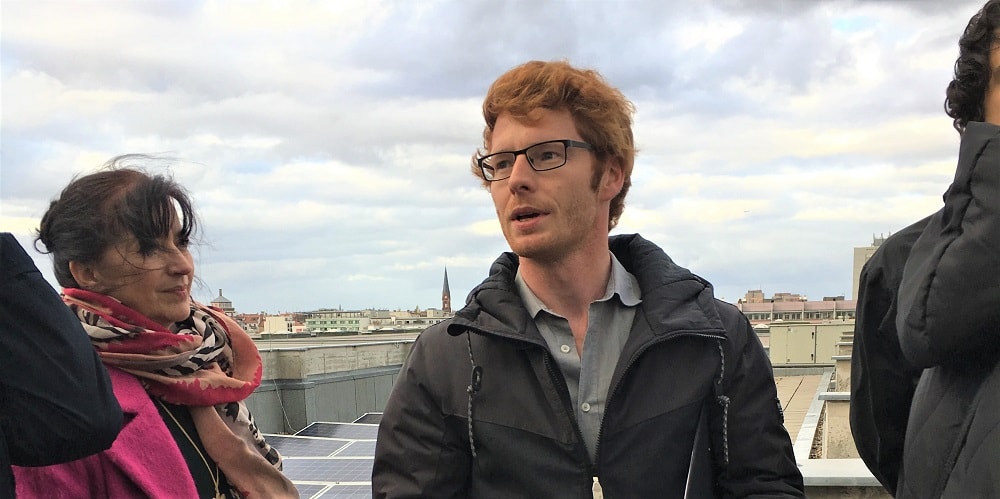Germany pioneered broad support measures for renewable energy by the late 1990s. These measures, referred to as Energiewende or ‘energy transformation’, offer a valuable insight for other countries, which introduced support mechanisms for renewable energy later or have not done so yet.
Maksis Apinis, National campaigner | 19 November 2018

Albert Dietrich, Project manager at Berliner Stadtwerke
First steps
As early as 2000, Germany introduced the Renewable energy act, which envisioned extra financial support to those who produced decentralised energy and fed it into the common network, thus receiving a special component of the tariff.
Energy intensive industries were exempted from this feed-in tariff, in order to not harm the economy. But every other electricity consumer paid a certain amount for the renewable electricity with this slightly elevated feed-in tariff. Currently consumers pay extra 6.79 euro cents for each consumed kWh (from 2019 – 6.405 cents/kWh).
The introduction of this support scheme for renewable energy resulted in, first of all, a rapid increase in the number of renewable energy producers and the proportion of renewables in the overall energy mix – from both bigger producers and prosumers. Second, the expanding renewable technology sector created new businesses and jobs.
As the costs of renewable technologies went down, the proportion of produced renewable energy went up, and energy got cheaper. Thus, around 2008 the feed-in tariffs were reduced: first, for solar installation, and a few years later – for wind and biomass cogeneration stations.
The Energiewende’s main achievement is that the proportion of renewable energy in the overall consumed electricity rose from 3.4 % in the 1990s to almost 40 % today. The rest of the electricity is mostly produced from coal and gas.
“It was carried out by people. Everybody could be part of the Energiewende by installing their own renewable energy sources. This really made up the success of the Energy transformation and brought acceptance that we are still relying on”, told Frank Peter, Deputy Executive Director of Agora Energiewende.
It was not a road without pitfalls. Energiewende has been heavily criticised for inducing a significant increase in electricity prices. Initially, no one forecasted such a rapid expansion of renewable energy production, which burdened electricity consumers during these years.
However, German environmental organisations and state institutions do not view this as a failure. It was unavoidable and necessary, and the investment will definitely pay off. The threats of uncontrolled climate change would be a lot more expensive in the long term.
And the public seems to be on board: Energiewende still enjoys public support. As many as 85-90 % of German citizens support transition towards cleaner energy.
Other support mechanisms and alternatives
Besides the feed-in tariff for renewable energy, other support measures include:
- Auction mechanisms for larger projects, such as wind park construction;
- Support for installing decentralised renewable energy sources;
- Possibility to install renewable energy source in one’s property without initial investment by signing a long-term contract with a state agency that covers the initial investment, provides maintenance and gradually recoups their investment.
The feed-in tariff is not necessarily the best way to support renewables. The most fair and sustainable solution would be the introduction of CO2 tax for all commodities and services, across all sectors. It would be an actual implementation of the ‘polluters pay’ principle, which would automatically make polluting activities financially disadvantageous. Currently, this matter is not on the national agenda in Germany, as it would require radical changes in the tax system as a whole. However, in the future Germany could follow the example of France and the Netherlands, which have introduced such principle in one way or another.
Going beyond green energy production
Despite the early successes of Energiewende, Germany’s greenhouse gas (GHG) emissions have increased, putting it below the GHG reduction target for 2020.
Partly, it is due to the economic growth, increasing population and intensifying transportation sector, which is reducing emissions too slow. But it is also due to insufficient energy efficiency promotion. The goal was to renovate and insulate at least 2 % of residential buildings each year, yet currently the figure is at 0.8 %.
There is no shortage of financial support. It is effective and available for individuals and companies; for multi-apartment residential buildings, private housing, and industries; for construction of new buildings, as well as renovating the existing ones.
However, current implementation of insulation projects is slowed down by the fact that half of all dwellings are being rented out, which hinders the insulation activities in these apartments and props up rent prices by approximately 11 %. At the same time, the savings on heating bills do not cover the increase of the rent price.
For Germany, it is crucial to continue phasing out coal, which requires not only developing renewable energy sources, but also addressing the issue of employment of whole regions. At present the government views natural gas as a bridge from coal and nuclear energy to renewables. Thus, the Nordstream 2 project will most likely be implemented despite its obvious flaws. Projects of this scale operate for at least 30 years, effectively eliminating the possibility of reaching the 2050 zero GHG emission target. If we wish to achieve the climate and energy targets, natural gas must be abandoned now.
As Germany makes its way forward, we can learn by observing. Energiewende gives away the wealth of knowledge accumulated over the past 20 years to create shortcuts for other countries that are just starting their energy transformation journeys.
Never miss an update
We expose the risks of international public finance and bring critical updates from the ground – straight to your inbox.
